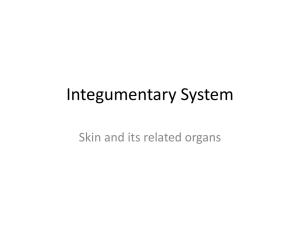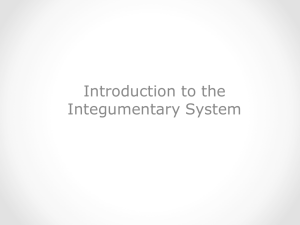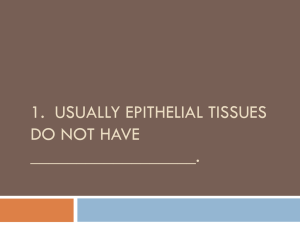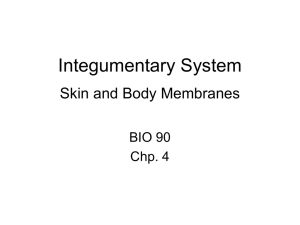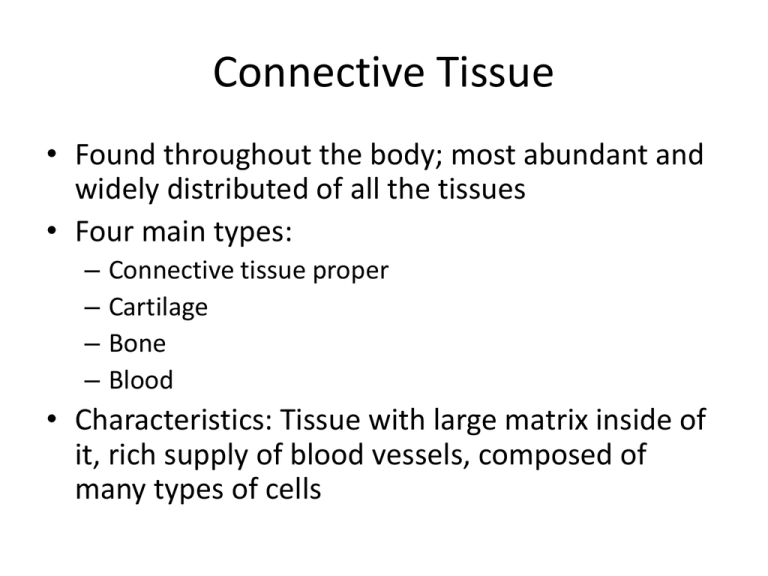
Connective Tissue
• Found throughout the body; most abundant and
widely distributed of all the tissues
• Four main types:
–
–
–
–
Connective tissue proper
Cartilage
Bone
Blood
• Characteristics: Tissue with large matrix inside of
it, rich supply of blood vessels, composed of
many types of cells
Connective Tissue Proper:
Areolar
• Fibers: collagen,
elastic
• Wraps and
cushions all
internal organs
• Attached to all
epithelial tissue
• Dermis: small
layer of areolar
tissue
Connective Tissue Proper:
Dense Regular Tissue
• Dense because the
collagen fibers are
packed together
• Distinct wave: made to
withstand force in one
direction
• Found in tendons and
some ligaments and
aponeuroses
Connective Tissue Proper:
Adipose
• The “spaces” are the cells,
with nuclei squished
against the sides
– The clear parts are oil
droplets
• Function: insulation,
cushions and protects
organs, and reserve fuel
• Found: under skin in the
abdomen, around kidneys
& eyeballs, in breasts
Connective Tissue Proper:
Reticular
• Provides a framework
for white blood cells,
mast cells and
macrophages = all part
of the immune system
– Lymphoid organs:
spleen lymph nodes
and bone marrow
Connective Tissue:
Bone
Haversian Canal
a series of tubes around narrow channels formed by
lamellae
Osteoblast
Bone forming Cells
Osteocyte
an osteoblast that has become embedded within the
bone matrix, occupying a bone lacuna
Lamella
Osteoblasts deposit the matrix in the form of thin
sheets which are called lamellae.
Canaliculi
Canaliculi provide the means for the osteocytes to
communicate with each other and to exchange
substances by diffusion.
Lacuna
In the matrix, osteoblasts become encased in small
hollows within the matrix
Volkmann’s Canal
These canals establish connections of the Haversian
canals with the inner and outer surfaces of the bone
Bone (osseous tissue)
• Compact bone: looks
like rings of tree
• Function: structural
support, give body
its shape, act as
attachment points
for muscles
• Location: bones
Connective Tissue: Spongy Bone or
Cancellous Bone
• Doesn’t occur in
ring shape like
compact bone
• Still has lacuna
– *single lacuna
spread out
• Rest of tissue
(pink) is called
trabeculae
Connective Tissue:
Spongy Bone
Red marrow (consisting
mainly of hematopoietic)
tissue and Red blood cells,
platelets and most white
blood cells arise in red
marrow, found mainly in
the flat bones.
Yellow marrow (consisting
mainly of fat cells). Yellow
marrow is found in the
hollow interior of the
middle portion of long
bones.
Connective Tissue:
Hyaline Cartilage
• Distinguishing
characteristic:
– Pairs of lacunae
• Supports and
reinforces structures
(like bone), but can
bend
• Found: ends of long
bones, connects ribs
to sternum, found at
end of nose, in
trachea and larynx
Connective Tissue:
Blood
• Mature red blood cells
do not have a nucleus
• WBC: have a nucleus
– Neutrophils and
Lymphocyte,
monocyte (pictured)
• Function: transport
respiratory gases
• Location: in blood
vessels
Muscle Tissue
• Highly specialized to contract and produces
most types of body movement
• Three types of Muscle Tissues:
– Smooth Muscle
– Cardiac Muscle
– Skeletal Muscle
Smooth Muscle Tissue
• Smooth: no striations
• Lines hollow structures:
– airways to lungs,
stomach, intestines,
gallbladder, and urinary
bladder
• Involuntary control:
propels substances
along predetermined
pathways
Skeletal Muscle
• Cells are long, multinucleated, and
striated
• Voluntary control
• Location: in skeletal
muscles attached to
bones or occasionally
to skin
Cardiac Muscle
• Uni-nucleated
• Intercalated discs allow
the cardiac muscle to act
as a unit
• Involuntary control
• Function: propels blood
into circulation as it
contracts
• Forms the bulk of the
wall of the heart
• Found: only in the heart
Nervous Tissue
• 2 main cell types found in nervous tissue
– Neuroglia: functionally support, protect and
insulate neurons and bind them together
– Neurons: respond to stimuli and conduct impulses
to and from all body organs
• Found: Brain, spinal cord, and nerves
Parts of the neuron
• Dendrites: branched processes that
receive stimuli and conduct nerve
impulses toward the cell body. (input
portion of neuron)
• Cell body: contains nucleus and
specialized organelles
• Axon: cytoplasmic extension that
conducts nerve pulses away from the
cell body. (output)
Integumentary System
• Skin (integument) – largest organ of the body
• Accessory organs: hair, glands, and nails
• Roles:
–
–
–
–
–
–
–
Mechanical and chemical protection
Thermal protection
Microorganisms
Prevents water loss
Secretory system (waste products)
Vitamin D synthesis
Cutaneous sense organs
Layers of the skin
• 2 main layers:
– Epidermis: stratified into 4 structural layers (or 5 layers
in palms and soles)
– Dermis: consists of 2 layers
• Hypodermis or superficial fascia (subcutaneous
layer)- not part of the skin, but binds dermis to
underlying organs
Epidermis
Dermis
• Second, deeper part of the skin
• Composed mainly of connective tissue
• Blood vessels, nerves, glands, and hair follicles
are embedded in the dermal tissue.
• Dermis is divided into a superficial papillary
region and a deeper reticular region
Dermis
• Papillary region – more superficial dermal
layer; in contact with epidermis;
– Composed of areolar connective tissue
– Dermal papillae –nipple shaped structures indent
into the epidermis and contain loops of capillaries.
Some dermal papillae contain tactile
receptors called corpuscles of touch or Meissener
corpuscles [4] which are touch receptors.
– Responsible for fingerprints
Dermis
• Reticular layer of
the dermis
– Deepest skin layer
– dense irregular
connective tissue
Hypodermis Layer
• Subcutaneous layer is deep to the dermis and
is not part of the skin
• Consists of areolar and adipose tissues
Glands of the Skin
Several kinds of exocrine glands are associated
with the skin
• Sudoriferous glands or sweat glands empty
their secretions onto the skin surface through
pores or into hair follicles.
• Sweat glands: two main types based on their
structure, location and type of secretion.
– Eccrine and Apocrine
Eccrine Sweat Glands
• Simple, coiled tubular glands are much more
common than Apocrine
• Regulate body temperature through
perspiration/evaporation
• Also plays a role in elimination – perspiration
is diluted urine
Apocrine Sweat Glands
• Found: skin of axilla, groin, anal regions, areolae areas of
the breasts, and bearded areas of the face in men.
• Begin functioning at puberty. In women cells of apocrine
sweat glands enlarge around ovulation and shrink during
menstruation
• Secretions are more viscous (thicker) than eccrine
secretions and contain the same compounds as eccrine
sweat plus lipids and proteins, pheromones.
– Pheromones are chemical signals exuded by many animals -including humans -- that evoke sexual behavior
• Mammary glands are specialized apocrine glands that
secrete milk
Sebaceous glands (oil gland)
• Usually connected to hair follicles
• Secrete sebum which is a mixture of fats, cholesterol,
proteins, inorganic salts and pheromones
• Sebum coats the surface of hairs and prevents excessive
evaporation of water from the skin, keeps the skin soft
and inhibits growth of certain bacteria
• Sebaceous glands are found in the skin all over the
body except for the palms of the hands and the soles of
the feet.
– grasping grip and the traction needed for the soles of the
feet would be compromised
Hair follicle
• Hair follicle surrounds the root and consists of
columns of dead, keratinized cells bonded
together by extracellular proteins
– Hair shaft is the superficial portion of the hair, most of
which projects from the surface of the skin.
– Hair root is the portion of the hair deep to the shaft
that penetrates into the dermis and sometimes into
the subcutaneous layer.
– Arrector pili muscle is the smooth muscle that extends
from the superficial dermis of the skin to the side of
the hair follicle
• Arrector pili muscle is the smooth muscle that
extends from the superficial dermis of the skin
to the side of the hair follicle. [14]
Microscope Slide #21



